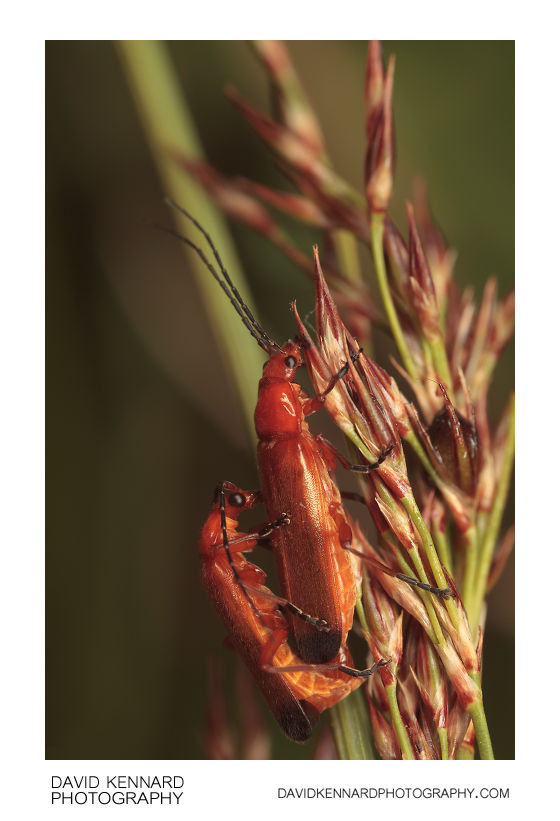Common Red Soldier Beetle (Rhagonycha fulva)

Description
- Title:
- Common Red Soldier Beetle (Rhagonycha fulva)
- Caption / Description:
-
The common red soldier beetle, Rhagonycha fulva, is a species of soldier beetle (Cantharidae).
The common red soldier beetle will grow up to a centimetre. Nearly all their body is coloured red yellowish. Only the last bit of the elytra is black. The body is flat and elongated. The chitin armour is very soft, resulting in the German name of this species as Weichkäfer (meaning "soft beetle"). The black thread-like antennae are also relatively long. The equally long legs have an orange colour, which become notably darker only at the end.
This beetle is very common in Europe and Anatolia. Introduced to North America, it is well-established in British Columbia and Quebec and recently recorded in Ontario. One will find it very often in bushes or on grass and fields.
These beetles are active during the daylight hours, when they will hunt mostly for small insects on top of flowers. Fairly often one will find many of them on Apiaceae or Asteraceae like thistles.
After copulation the females will lay her eggs. The larvae are soil-dwellers which hunt for snails and insects. After a year and several moults the larvae will pupate and then emerge as fully grown beetles.
Because of their red colour, these beetles are popularly known as blood suckers (but they do not actually suck blood.) Their habit of mating conspicuously on umbellifer heads has gained them the nickname hogweed bonking beetle.
Description taken from Wikipedia: http://en.wikipedia.org/wiki/Common_red_soldier_beetle
- Tags / Keywords:
-
- Biota
- Life
- Vitae
- Eukaryota
- Animalia
- Animals
- Arthropoda
- Arthropods
- Insecta
- Insects
- Coleoptera
- Beetles
- Cantharidae
- Soldier beetles
- Rhagonycha fulva
- Common red soldier beetle
- Rhagonycha
Admin
- Date Original Photo Taken:
- Original File Name:
- _MG_2977-8.psd
- Event:
- Rating:
- ☆
- Date this image added/last updated on website:
- Original File Dimensions:
- 2804px x 4298px
- File Type:
- JPEG
- Color Mode:
- RGB
- Original Image Color Profile:
- Adobe RGB (1998)
Location
- Location Created:
-
- Sublocation:
- City:
- Market Harborough
- Province/State:
- Leicestershire
- Country:
- United Kingdom
- World Region:
- Europe
- Geo-location:
- 52.474972600003, -0.95071 View on map
Rights
- Copyright Status:
- Copyrighted
- Licensing Status:
- Rights Managed
- Available for Editorial Use:
- Yes
- Available for Commercial Use:
- Yes
- Copyright Notice:
- © 2010 Dave Kennard
Camera Data
- Date Digital Resource was created:
- Shutter speed:
- 1⁄200 s
- Aperture:
- f/8
- Camera Model:
- Canon EOS 450D
- ISO:
- 100
- Exposure Compensation:
- 0
- Focal Length:
- 65mm
- Focal Length (35mm equiv.):
- Metering Mode:
- Multi-segment
- Flash:
- On, Fired
- Exposure Mode:
- Manual
- White Balance:
- Manual
- Light Source:
- Exposure Program:
- Manual
Additional shooting metadata
- Lens:
- Canon MP-E 65mm F2.8 1-5x Macro
- Filters used:
- Additional Optics used:
- Setup:
- Handheld, 2 shots
Canon MT-24EX Macro Twin Flash with home-made concave diffusers
Post Processing
- Image Modified:
- Software used:
-
- Adobe Camera RAW
- Adobe Photoshop CS5
- Post Processing:
-0.15 exposure compensation in ACR
Images blended for focus in PS CS5
Curves adjustment to increase contrast in PS CS5
